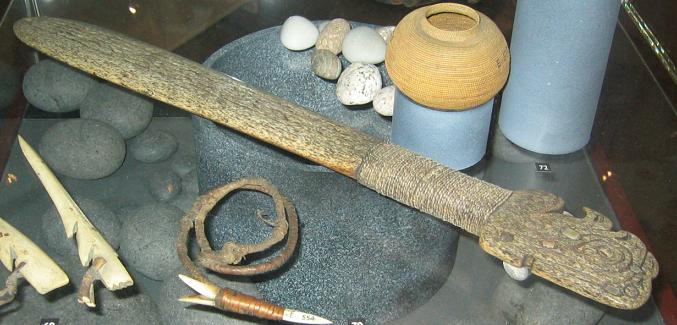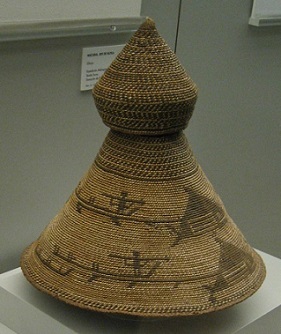Subject: warrior
Culture: Nootka-Makah / Nuu-chah-nulth
Setting: tribal warfare, Northwest Coast late 18th-19thc
Evolution:
Context (Event Photos, Primary Sources, Secondary Sources, Field Notes)
*
Hat
*
Armor
* Paterek 1994 p319
"Chiefs wore armor of double layers of elk skin, occasionally strengthened by wooden rods sewn to the outside; these were often painted. Although elk hide seems to have been the most common form of armor, some examples of Nootka armor have been preserved that are of the 'slat-and-rod' type. Warriors painted their faces black. No helmets were used."
Guns
* Moziño 1991 p16 (writing in 1792)
"Today they handle all the European arms of flints, sabers, and swords with special dexterity. Despite the fact that these [weapons] are an article of commerce for which many of them have singular affection, in time the exchange of arms may be fatal to the very ones who have provided them. The English captains Brown and Baker have already experienced in Clayoquot the fatal consequences of two hundred guns, and I do not know how many barrels of powder, which were supplied to Wickinanish."
Archery
* Moziño 1991 p16 (writing in 1792)
"Their bows are small and not very flexible, and their arrows very poorly prepared; they are suspended from the shoulder over the back in a quiver of bearskin."
Basic Costume
* Paterek 1994 p317
"Men usually went naked. In cooler weather they donned a tunic of woven cedar bark, worn under one arm and fastened on the opposite shoulder. Another type of garment was a rectangular mat or robe of cedar bark that was wrapped around the hips and held in place with a belt. Both items of dress were edged with white fur, or if the individual was wealthy, strips of sea-otter fur."
* Moziño 1991 p13-14 (writing in 1792)
"Their dress is very simple. It commonly consists of a square cape woven from beaten cedar fibers and the wool of some quadruped, which I suspect to be a bison or mountain goat. They are provided with these by trade with the Nuchimanes, who perhaps have some commerce with the tribes of the continent where these beasts are found in abundance. The capes scarcely reach the ankles and even leave their bodies completely exposed along the entire right side; this is the shoulder on which they wear the strap that forms the opening for the head.
"This outfit is used more by custom, or perhaps for protection against the inclemencies of the cold, than for decency. Either because it is natural among them or because they have eliminated all sentiments of modesty entirely, the men frequently abandon this clothing and appear stark naked, without so much as covering their private parts with their hands, even though they might be in a group of numerous women. The women, on the contrary preserve more decency. In addition to using the capes doubled, and drawing in the inner part with a narrow twisted cord, they hang a thin piece of cloth with a long fringe from the belt. This is made from the same cedar fibers used in weaving the capes. In a similar manner they usually have their breasts hidden under a short cape or closed cloak which is of the same material and made purposely in such a way that not a single seam is visible. Their best clothing consists of the finest and most delicate material. They decorate all its edges with a border of otter skin and a plush or velvet material which they make by using the soft fur of the same animal as nap, and the fibers and wool already referred to for the weft and warp.
"The men also dress in bearskins, which are extremely black, large, and have very long hair.
"The sea otter provides a garment reserved only to the nobles of the first rank. It is formed from three good skins, two of which are left whole; from the third are made a number of equal strips, the ends of which protrude on both sides, and of this they make a cuff that has a certain elegance. The underside is ordinarily painted red with whimsical figures. When the weather is hot, they leave the fur on the outside; reversed, it provides them with great protection in winter. In order to augment their finery, they sew on various tails of the same amphibious animal as a kind of trimming placed on the suit."
Spear
* Moziño 1991 p16 (writing in 1792)
"[T]he shaft of the lance is almost five yards long, and the barb more than one geme (the longest distance from the end of the thumb to the tip of the forefinger); the former is of pine or cedar, and the latter of copper, shell, or iron."
Club
* Taylor 2001 p16-17
"[E]laborate wooden clubs were developed by the Northwest Coast tribes, such as the Nootka and Kwakiutl. Exhibiting carvings which not infrequently made reference to tribal mythology, such clubs were more used in the ceremonial context rather than on the battlefield and some were referred to as 'slave killers' (although there is little evidence to suggest that they actually performed that function).
Jewelry
* Moziño 1991 p11-12 (writing in 1792)
"
Body Art
* Moziño 1991 p12-13 (writing in 1792)
"

